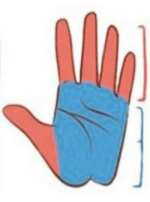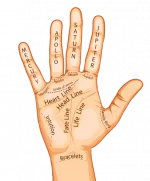Introduction
In the intricate landscape of palmistry, where lines and symbols reveal the hidden facets of our lives, the “fate line” stands as a captivating enigma. Often believed to hold the key to our destiny and life’s journey, the fate line has sparked curiosity and contemplation for generations. In this blog post, we’ll embark on a journey of exploration into the captivating world of the fate line, unraveling its significance and shedding light on its role in the ancient art of palmistry.
Palmistry: A Glimpse into the Unknown
Palmistry, or chiromancy, offers a captivating glimpse into the mysteries of our lives through the interpretation of lines, shapes, and patterns on our palms. Rooted in cultures spanning across time and geography, palmistry has been used to provide insights into personality traits, life events, and even potential paths to success. While palmistry doesn’t possess scientific validation, it continues to intrigue and inspire individuals seeking a deeper connection with themselves.
The Fate Line: Mapping Your Life’s Trajectory
The fate line, also known as the Saturn line or career line, is a vertical crease that often extends from the base of the palm towards the middle or index finger. While its prominence varies from person to person, it’s commonly associated with matters related to career, destiny, and life’s journey. Contrary to the belief that the fate line solely dictates one’s fate, it is better understood as a guide that offers insights into an individual’s potential and the choices that shape their path.
- Presence and Absence: The presence, absence, or prominence of the fate line can indicate an individual’s approach to life. A clear, well-defined fate line might suggest a focused and determined individual, while its absence could signify a free spirit who charts their own course.
- Length and Direction: The length and direction of the fate line can provide insights into the trajectory of one’s career and life. A straight and unbroken line might suggest a clear and steady career path, while a curved or fragmented line could indicate detours or changes in direction.
- Crossings and Branches: Crossings or branches intersecting the fate line can represent significant life events or decisions that impact one’s career or life’s course. These intersections might correspond to moments of change, challenges, or opportunities.
- Beginnings and Endings: The point where the fate line starts and ends can provide insights into an individual’s early life influences and potential shifts in career or life focus as they age.
Empowering Interpretation
Instead of viewing the fate line as a fixed blueprint, consider it a map that provides insights into potential paths and choices. Palmistry should be embraced as a tool for introspection and self-discovery, rather than a deterministic predictor of fate. Exploring the fate line can prompt meaningful reflection on your aspirations, strengths, and areas for growth.
Conclusion
The fate line on your palm is more than just a line etched on the canvas of your hand; it’s a symbolic representation of your journey through life. While palmistry remains an art that stirs curiosity and wonder, its true value lies in its ability to encourage self-awareness and personal growth. The fate line is a reminder that our lives are not predestined, but rather a dynamic interplay of choices, circumstances, and our own unique essence. As you gaze upon your palm, envision the fate line as a guide, inviting you to navigate the labyrinth of life with purpose and authenticity.

